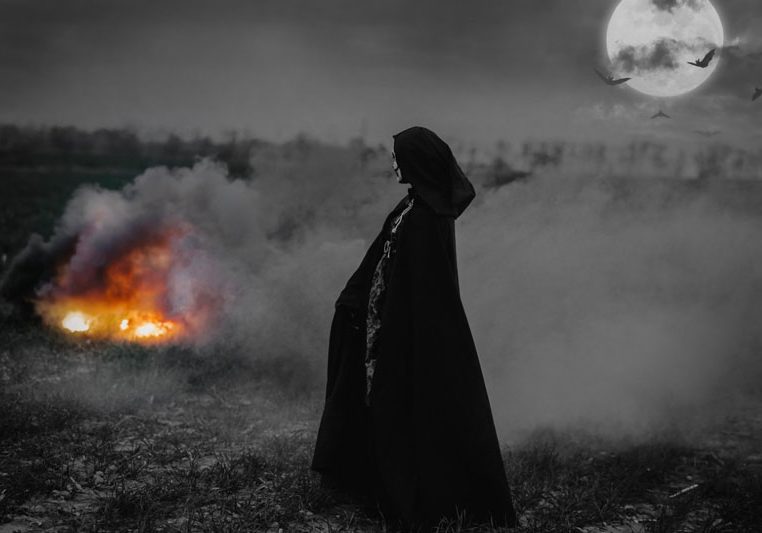
The Grim Tale of The Pendle Witches
by Maureen Stopforth
A soft early morning mist fills the valley, and the early morning sun turns the sky a soft pink colour, turns the valley into a Chinese watercolour, with just the hilltops and trees being the only features visible. Looking at this scene from my bedroom window, it’s hard to imagine that this area of outstanding natural beauty was the scene of the terrible events of 1612, which led to the deaths by hanging of so many local people.
I was born in Colne, but lived for most of my life in Nelson, until I came – unwillingly – to Newchurch 40 years ago. I knew little of the story of the Pendle Witches, but I’ve learned over the years, a story of which interests and intrigues young and old who come to Pendle to discover more of the story of the events of 1612, but they are blown away by the beauty of the area and many of them return again and again to enjoy the peace and serenity that pervades this beautiful place.
In 1593, James VI of Scotland had become James I of England. He had set about ridding the country of witches and witchcraft, and although these were witch trials held all over England, the Lancashire Witches were the best known because they were the best-documented trials of all. Thomas Potts was Clerk of the Courts at Lancaster Assizes in August 1612. He made notes of the trials, under the direction of the presiding judges and in 1613 brought out his book, ‘The Wonderfull Discoverie of Witches in the Countie of Lancaster.’
The story of the Pendle Witches mainly involved two local families, each headed by a matriarch in her eighties. Anne Whittle, known as ‘Chattox’, a widow, lived with her daughter Anne and her husband, Thomas Redferne and two or three other members of the family, who lived on land belonging to Christopher Nutter, of Greenhead. In 1595 it was believed that Chattox had bewitched the son of Christopher Nutter and caused his death. Robert Nutter died and soon after his father became ill and died some three months later. These deaths, supposedly by witchcraft, were the first to be reported when inquiries began later in 1612.
Elizabeth Southerns, known as Demdike, or Old Mother Demdike, lived with her family not far away at a dwelling called Malkin Tower, her daughter, also named Elizabeth, with her husband John Device and their children, Alizon, James and Janet.
When John Device died, Elizabeth and her family scraped a living mainly by begging. Old mother Demdike was blind and when she taken to Lancaster Prison, she died before her trial took place.
In March 1612 Alizon Device, grand-daughter of Demdike, and a girl of 13 or so, well used to begging, was involved in an incident which was to set off a chain of events which led to the trials in August that year. Alizon was on the road from Colne to Trawden when she met a pedlar, John Law from Halifax. Alizon asked him to give her some pins from his pack but when she told him she had no money he refused and she became angry with him. He walked away from her a short distance but then collapsed and fell to the ground, – ‘bewitched’ – he probably had a stroke. He was taken to an inn in Colne and his son Abraham sent for. He went to find Alizon, and brought her to his father, who, when his speech returned, accused Alizon of witchcraft and she confessed. John Law did recover, but Abraham took Alizon to Read Hall with her mother Elizabeth and her brother James.
Roger Nowell was the magistrate living at Read Hall. The laws were different in the 1600’s. He was within his rights to hold and question any prisoners himself, searching for evidence and getting up a case against the prisoners himself. If a magistrate wished to curry favour with the King, who hated and feared witches, pointing a finger at a group of troublesome individuals was a good way to go about it.
Perhaps the best-known name locally is the one of Alice Nutter, who unlike those charged, was a gentlewoman, whose family lived at Roughlee Hall, which is still standing divided now into separate dwelling houses. Later research suggests that Alice herself lived at Damhead.
An educated woman, she apparently made no attempt to defend herself against the charges made at Lancaster Assizes. Because of her support of the Catholic faith, she would have put friends and family in danger if she had spoken out, so perhaps she died a martyr. A grave in the churchyard at Newchurch has become known as ‘the witches grave’. One of several graves belonging to the Nutter family, it is unlikely that Alice’s remains are buried there.
The poor ‘witches’ were charged with witchcraft by Roger Nowell and, escorted by Henry Hargreaves the constable, were made to walk from Pendle to Lancaster Castle where they were imprisoned in a dungeon below the well tower. The journey of over 40 miles was made on foot, and took several days. A few years ago I was able to make that journey myself with a film crew – but not on foot. We were given access to the underground dungeon where so many poor souls were held from April until the assizes in August, an underground chamber with no natural light or fresh air, the walls damp and musty, the flagged floor of the cellar with two iron rings to which prisoners were chained. They had no facilities whatsoever, probably a daily meal of gruel and water. I found the experience very moving, to realise how horrendous the conditions were, bearing in mind that there were two woman in their eighties and several children in the group.
A whole industry has grown up based on the story of the Pendle Witches, and you cannot travel far into the Borough of Pendle without seeing some symbol on caricature of a witch. I often wonder what on earth those involved in the story would make of the fact that their names are now emblazoned on the sides of buses or that television programmes are made about their story…




